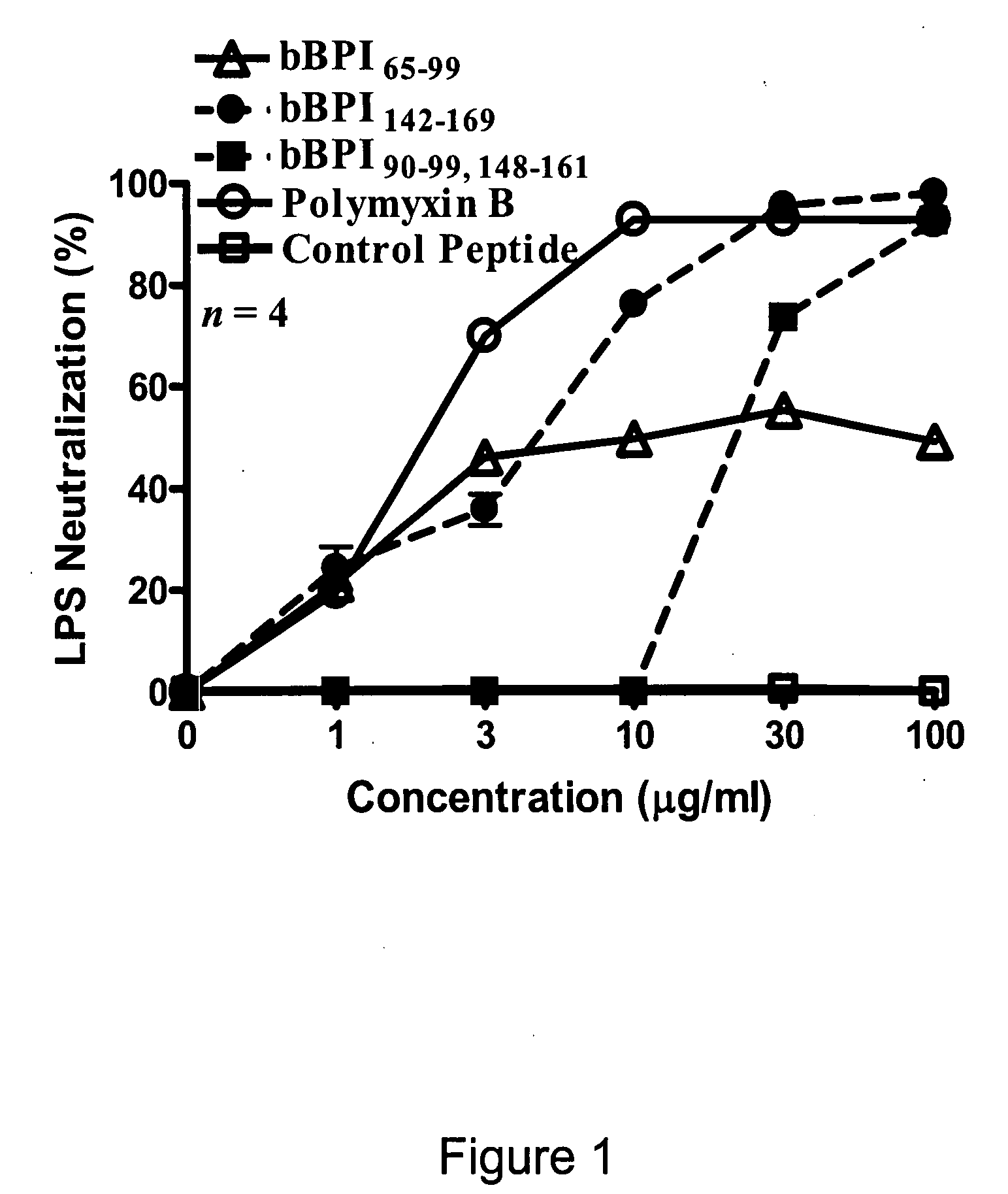Antimicrobial activity of bovine bactericidal/permeability-increasing protein (BPI)-derived peptides against Gram-negative bacterial mastitis isolates
a technology of permeability and increasing protein, which is applied in the direction of peptides, drug compositions, dna/rna fragmentation, etc., can solve the problems of insufficient therapeutic treatment for intramammary gram-negative bacteria, insufficient anti-inflammatory response elicited by lps, and relatively little impact on controlling mastitis caused by environmental pathogens
- Summary
- Abstract
- Description
- Claims
- Application Information
AI Technical Summary
Benefits of technology
Problems solved by technology
Method used
Image
Examples
example 1
Bovine BPI Peptides
[0049]Peptides corresponding to the sequence of bBPI amino acids 65-99 (bBPI65-99; NSQIRPLPDKGLDLSIRDASIKIRGKWKARKNFIK; SEQ ID NO:2), 142-169 (bBPI142-169; VRIHISGSSLG WLIQLFRKRIESLLQKS; SEQ ID NO:3), or the combination of amino acids 90-99 and 148-161 (bBPI90-99,148-161; KWKARKNFIKGSSLGWLIQL FRKR; SEQ ID NO:4) were commercially synthesized (Genemed Synthesis, Inc., South San Francisco, Calif.). The amino acid numbers correspond with those of the mature form of bBPI. A control peptide (amino acid sequence: MCHWAGGASNTGDARGDV FGKQAG; SEQ ID NO:5) was provided by the same company that synthesized the bBPI-derived peptides. The peptides were reconstituted in citrate-buffered saline (CBS; 20 mM sodium citrate, 150 mM sodium chloride, 0.1% pluoroconic acid, and 0.002% polysorbate 830, pH 5.0; Sigma Chemical Co., St. Louis, Mo.) to a final concentration of 10 mg / ml, aliquotted, and stored at −20° C. All aliquots were thawed only once. Immediately prior to use, aliquotte...
example 2
Bacterial Strains
[0050]Bacterial isolates of Escherichia coli, Klebsiella pneumonia, Serratia marcescens, Pseudomonas aeruginosa, Enterobacter cloacae, and Enterobacter aerogenes, which were obtained from clinical cases of bovine mastitis, were used to assess the bactericidal activity of peptides in a broth microdilution assay. Isolates were obtained from repositories at Cornell University (gift of Dr. Y. H. Schukken; Quality Milk Production Services Program, Cornell University, Ithaca N.Y.) and the USDA Beltsville Agricultural Research Center. E. coli strain P4 (gift of Dr. A. J. Bramley, Institute for Animal Health, Compton Laboratory, Newbury, England), which was originally isolated from a clinical case of mastitis (Bramley, A. J. 1976. J. Dairy Res. 43: 205-211) was also used to assess the bactericidal activity of the peptides in biological fluids. Reference strains of E. coli (ATCC 25922) and Staphylococcus aureus (ATCC 29213) were obtained from a commercial source (American Ty...
example 3
Bacteriostatic and Bactericidal Activity of Bovine BPI Peptides Against Clinical Mastitis Bacterial Isolates
[0051]To evaluate the antimicrobial activity of the peptides against various clinical mastitis bacterial isolates, the minimum inhibitory concentration (MIC) and the minimum bactericidal concentration (MBC) of these peptides against the isolates were determined using a standardized broth microdilution assay. In addition to the mastitis isolates, E. coli (ATCC 25922) and S. aureus (ATCC 29213) reference strains were evaluated. Tetracycline (Sigma Chemical Co.) MIC and MBC values for the various bacteria were determined as well. The assays were performed in accordance with Clinical and Laboratory Standards Institute (CLSI) [formerly National Committee for Clinical Laboratory Standards (NCCLS)] guidelines (National Committee for Clinical Laboratory Standards. 1999. Methods for Determining Bacterial Activity of Antimicrobial Agents: Approved Guideline. Wayne, Pa.; National Committ...
PUM
| Property | Measurement | Unit |
|---|---|---|
| concentration | aaaaa | aaaaa |
| concentration | aaaaa | aaaaa |
| concentrations | aaaaa | aaaaa |
Abstract
Description
Claims
Application Information
 Login to View More
Login to View More - R&D
- Intellectual Property
- Life Sciences
- Materials
- Tech Scout
- Unparalleled Data Quality
- Higher Quality Content
- 60% Fewer Hallucinations
Browse by: Latest US Patents, China's latest patents, Technical Efficacy Thesaurus, Application Domain, Technology Topic, Popular Technical Reports.
© 2025 PatSnap. All rights reserved.Legal|Privacy policy|Modern Slavery Act Transparency Statement|Sitemap|About US| Contact US: help@patsnap.com



